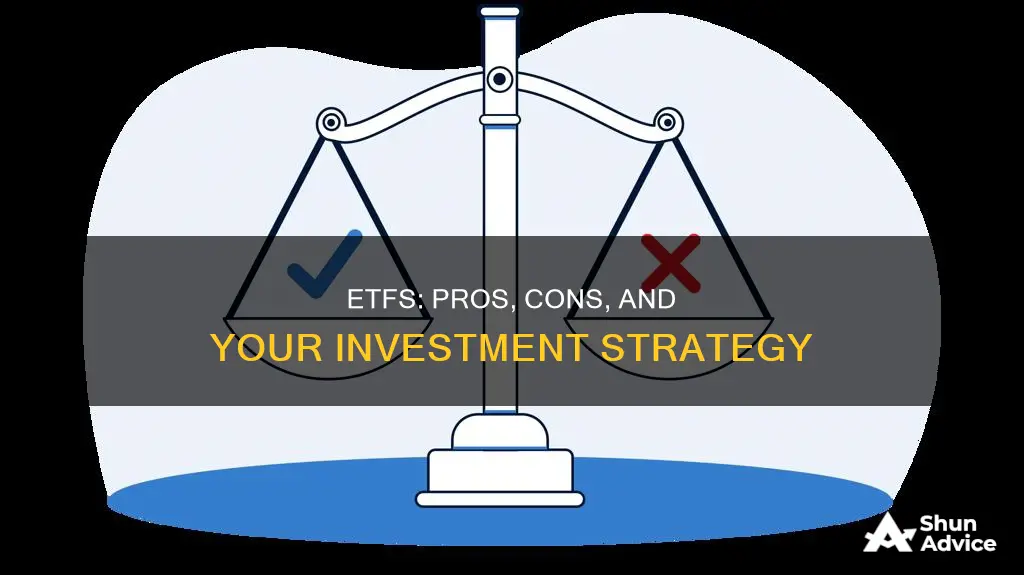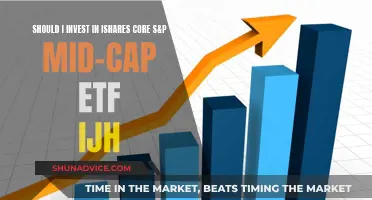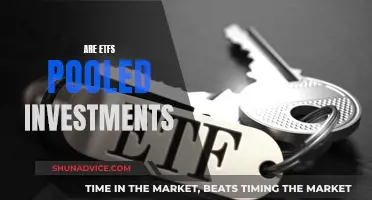
Exchange-traded funds (ETFs) are a popular investment vehicle due to their broad diversification, wide availability, and relatively low costs. ETFs are funds containing groups of securities, like stocks or bonds, often organised around a specific theme, such as a sector or market index. They combine the features of mutual funds and stocks, providing investors with various advantages and disadvantages. So, what are the pros and cons of investing in ETFs?
| Characteristics | Values |
|---|---|
| Trading flexibility | ETFs can be bought and sold during market hours, allowing investors to make timely investment decisions |
| Diversification | ETFs provide access to a wide range of stocks, sectors, currencies, and countries, reducing risk |
| Cost | ETFs have lower expense ratios and trading costs compared to other investment options |
| Control | Investors have less control over investment choices in an ETF as they buy into a pre-made fund |
| Returns | ETFs may provide lower returns than individual stocks |
| Management fees | Actively managed ETFs have higher fees, which can offset returns |
What You'll Learn

ETFs are low-risk and low-cost
Exchange-Traded Funds (ETFs) are considered low-risk investments because they are low-cost and hold a basket of stocks or other securities, increasing diversification.
ETFs are often a more affordable option for investors, as they have much lower expense ratios compared to actively managed funds. They are passively managed, meaning they track an index's performance rather than aiming to outperform it, which reduces the costs associated with active management, such as research and analysis. The average ETF costs half as much as the average mutual fund (0.50% vs 1.01%). This passive management structure also means that ETFs typically have lower annual expenses.
ETFs are also more tax-efficient than mutual funds. As passively managed portfolios, they tend to realise fewer capital gains than actively managed funds. Mutual funds are required to distribute capital gains to shareholders if the manager sells securities for a profit, and this distribution amount is taxable.
The structure of ETFs helps to maintain their liquidity and efficiency. They are traded on stock exchanges and can be bought and sold throughout the trading day at market prices, giving investors flexibility and the ability to react quickly to market changes. This trading flexibility also contributes to higher liquidity, allowing investors to execute trades quickly at market prices.
ETFs are a great option for investors looking to diversify their portfolio. They hold a diversified portfolio of assets, such as stocks or bonds, and a single trade can gain exposure to hundreds or even thousands of different companies or bonds. This diversification helps to mitigate risk because the performance of different securities can offset each other. When one market or sector is down, another might be up, stabilising investment returns over time.
Overall, ETFs are a valuable tool for achieving investment goals, offering low-cost, flexibility, and diversification.
A Beginner's Guide to Investing in First Metro ETFs
You may want to see also

They offer broad diversification
ETFs are an effective investment vehicle that offers broad diversification across various asset classes, helping investors to spread their risk. This diversification is a significant benefit of ETFs, giving investors access to a comprehensive spectrum of securities through a single transaction. For example, a single global equity ETF might hold stocks from hundreds of companies across different countries and industries, reducing the risk of investing in only a few stocks.
ETFs are designed to track various indices, sectors, commodities, bonds, or a mixture of investment types. This means that investors can gain exposure to a wide range of stocks from multiple companies, sectors, currencies, and even countries in a cost-effective way. Many ETFs specialize in specific equities, industry sectors, bonds, and currencies, which can help diversify your portfolio, especially if you're not an expert in these areas.
International, regional, and industry-focused ETFs may be easier to invest in than buying individual stocks and bonds, and they generally offer lower average costs than buying all the individual stocks held in an ETF. When you buy an ETF, you automatically gain access to all the holdings in the fund, and it only takes one transaction to sell the fund, resulting in significant savings in broker commissions.
ETFs are also structured to track the performance of a specific index or sector, achieving this by using creation and redemption mechanisms. Authorized participants can create new shares or redeem existing shares, ensuring that the ETF's price remains in line with the underlying assets, helping to maintain the liquidity and efficiency of ETF trading.
Diversification helps to mitigate risk because the performance of different securities can offset each other. When one market or sector is down, another might be up, stabilizing investment returns over time.
JETS ETF: Worth the Investment Risk?
You may want to see also

They are flexible and easy to trade
Exchange-traded funds (ETFs) are a popular investment vehicle due to their broad diversification, wide availability, and relatively low costs. They are also flexible and easy to trade.
ETFs can be bought and sold throughout the trading day at market prices, giving investors the flexibility to react quickly to market changes. This is in contrast to traditional mutual funds, which are priced at the end of the trading day and can only be traded once daily after the markets close. The ability to trade throughout the day means that investors can make timely investment decisions and know immediately how much they paid or received for the shares traded.
ETFs are listed on public exchanges, which means they can be bought and sold during normal market hours, just like stocks. This flexibility allows investors to make the same types of trades as with common stocks, including limit orders, stop-limit orders, options, and short selling.
The structure of ETFs also helps to maintain liquidity and efficiency in trading. ETFs are designed to track the performance of a specific index or sector, and they do this by using creation and redemption mechanisms. Authorised participants can create new shares or redeem existing ones, ensuring that the ETF's price remains in line with the underlying assets. This helps to provide liquidity, which is crucial as it allows investors to execute trades quickly at market prices.
The flexibility and ease of trading offered by ETFs make them an attractive option for investors, particularly those who want to be able to react quickly to market changes.
ETFs vs Day Trading: Which Investment Strategy is Better?
You may want to see also

They have lower expense ratios
Exchange-traded funds (ETFs) are popular investment vehicles due to their broad diversification, wide availability, and relatively low costs. ETFs typically have lower expense ratios than traditional mutual funds. This is mainly because most ETFs are passively managed, aiming to replicate an index's performance rather than outperform it, which reduces the costs associated with active management, such as research and analysis.
First, ETFs are structured differently from mutual funds. Unlike mutual funds, which are priced at the end of the trading day, ETFs can be bought and sold throughout the trading day at market prices. This gives investors flexibility and the ability to react quickly to market changes. The operational costs of ETFs are generally lower than those of mutual funds. For instance, since ETFs are bought and sold on exchanges through a trading account, investors incur brokerage fees but avoid some of the sales charges and ongoing fees associated with mutual funds. Over time, these lower costs can result in significant savings for investors, making ETFs an attractive option for cost-conscious investors.
Second, ETFs are often passively managed, aiming to replicate the performance of an index rather than outperform it. This passive management style reduces the costs associated with active management, such as research and analysis. Actively managed funds, on the other hand, aim to outperform the market and often come with higher fees since they require management to guide the fund. These higher fees can offset returns over time, especially if the ETF underperforms.
Third, ETFs that track an index generally make few changes to their holdings, which can help improve tax efficiency. ETFs can be more tax-efficient than mutual funds as passively managed portfolios tend to realise fewer capital gains than actively managed funds. Mutual funds are required to distribute capital gains to shareholders if the manager sells securities for a profit, and this distribution amount is taxable. ETFs, on the other hand, do not carry a sales load, meaning there is no compensation paid to the sales team, which further reduces costs.
Finally, the unique creation and redemption processes of ETFs also contribute to their lower costs. Authorised participants can create new shares or redeem existing shares, ensuring that the ETF's price remains in line with the underlying assets. This structure helps maintain the liquidity and efficiency of ETF trading, providing cost efficiency for investors.
Japan ETF Investment: A Guide to Getting Started
You may want to see also

They are tax-efficient
Exchange-traded funds (ETFs) are structured in a way that makes them more tax-efficient than other investment options. This is due to a few reasons:
Firstly, ETFs are passively managed, meaning they aim to replicate an index's performance rather than outperform it. This passive management style leads to reduced costs associated with active management, such as research and analysis fees. As a result, ETFs typically have lower expense ratios than traditional mutual funds.
Secondly, ETFs are traded on exchanges through a trading account, so investors incur brokerage fees instead of the sales charges and ongoing fees associated with mutual funds. Over time, these lower costs can result in significant savings for investors.
Additionally, ETFs that track an index tend to make few changes to their holdings, further improving tax efficiency. They also provide investors with a useful tool for tax-loss harvesting.
Finally, because ETF shares are bought and sold on exchanges, transactions occur between investors without an actual sale of the securities in the ETF package. This means there is usually no capital gains tax liability incurred, which is a significant advantage for investors.
However, it is important to note that there are still some circumstances in which an ETF must sell shares from its package, resulting in capital gains tax events. Therefore, investors are advised to consult tax professionals for guidance on complex tax matters.
Invest in Ethiopia ETF: A Guide to Opportunities and Risks
You may want to see also
Frequently asked questions
ETFs (Exchange-Traded Funds) are an effective investment vehicle that offers portfolio diversification and trading flexibility with relatively low expense costs. They are also highly liquid, transparent, and tax-efficient.
ETFs may have higher management fees, limited diversification, and may not beat individual stock returns. They are also subject to market volatility and the risks of their underlying investments.
Deciding whether to invest in ETFs depends on your investment goals, preferences, and risk tolerance level. ETFs may be a good option for those seeking more trading flexibility than traditional mutual funds, as well as those looking to diversify their portfolio with a single transaction.







